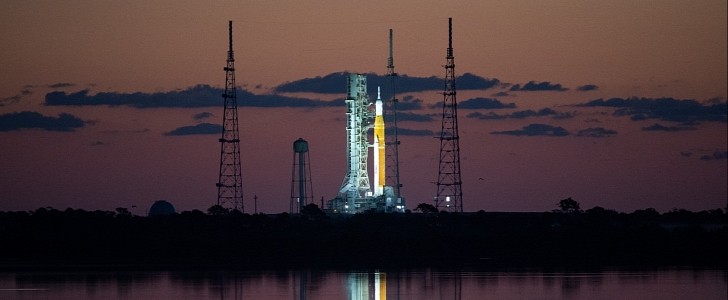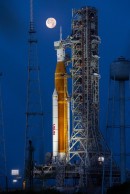Artemis I is the first mission that will allow humanity to explore the Moon and Mars for a longer time. It also will be a first step towards sending the first woman and the first person of color to the Moon. But first, let's start with a small introduction to the complexity of this rocket.
Orion is the name of the spacecraft that will help humans travel to space, and it is also the name of one of the best-known star constellations in the sky. It will launch from the new modernized spaceport at Kennedy Space Center in Florida. For its first flight, it is scheduled to reach the Moon uncrewed to prepare for the coming of humanity.
SLS, or the Space Launch System, is the name of the whole rocket and is very powerful. The most powerful, to be more specific. When it launches, it will hit a maximum of 8.8 million pounds (4,000 tons) of thrust, more than any other rocket before. This immense power will allow astronauts to explore not only Earth's close vicinity but far into the Solar System.
Finally, for the mission called Artemis I, there is only one month of waiting left until the first attempt of the launch. That will occur no earlier than August 29, at 8:33am EDT. After that, the mission duration, if the launch is successful, will be about 42 days long. It will cover a distance of 1.3 million miles (2.1 million km) before it returns to Earth on October 10, 2022, according to NASA.
A hydrogen leak, which is the rocket's fuel, was detected during the last wet dress rehearsal test, but engineers have now solved the problem with teams testing the connection in the Vehicle Assembly Building. The next step in this work is the completion of the thermal protection blankets, which will prevent hot air from entering the rocket, followed by removing the access platforms and installing flight doors. The finishing touch will be the removal of the inflatable seal between the mobile launcher's crew access arm and Orion's launch abort system, which is used by the technicians to get inside the spacecraft. After that, the astronauts will proceed in the same way on the launch day when they will go from the Tower's elevator, through the access arm, and right into the new home.
We hope that the Artemis I mission will accomplish its goals with the new rocket system and all the improvements seen in the past 11 years. Those objecti are to demonstrate Orion’s system safety and to bring us what we waited for so long, the establishment of a long-term human presence on the Moon. If triumphant, the mission will be followed by Artemis II, a crewed spacecraft planned from 2025 onwards.
SLS, or the Space Launch System, is the name of the whole rocket and is very powerful. The most powerful, to be more specific. When it launches, it will hit a maximum of 8.8 million pounds (4,000 tons) of thrust, more than any other rocket before. This immense power will allow astronauts to explore not only Earth's close vicinity but far into the Solar System.
Finally, for the mission called Artemis I, there is only one month of waiting left until the first attempt of the launch. That will occur no earlier than August 29, at 8:33am EDT. After that, the mission duration, if the launch is successful, will be about 42 days long. It will cover a distance of 1.3 million miles (2.1 million km) before it returns to Earth on October 10, 2022, according to NASA.
A hydrogen leak, which is the rocket's fuel, was detected during the last wet dress rehearsal test, but engineers have now solved the problem with teams testing the connection in the Vehicle Assembly Building. The next step in this work is the completion of the thermal protection blankets, which will prevent hot air from entering the rocket, followed by removing the access platforms and installing flight doors. The finishing touch will be the removal of the inflatable seal between the mobile launcher's crew access arm and Orion's launch abort system, which is used by the technicians to get inside the spacecraft. After that, the astronauts will proceed in the same way on the launch day when they will go from the Tower's elevator, through the access arm, and right into the new home.
We hope that the Artemis I mission will accomplish its goals with the new rocket system and all the improvements seen in the past 11 years. Those objecti are to demonstrate Orion’s system safety and to bring us what we waited for so long, the establishment of a long-term human presence on the Moon. If triumphant, the mission will be followed by Artemis II, a crewed spacecraft planned from 2025 onwards.






